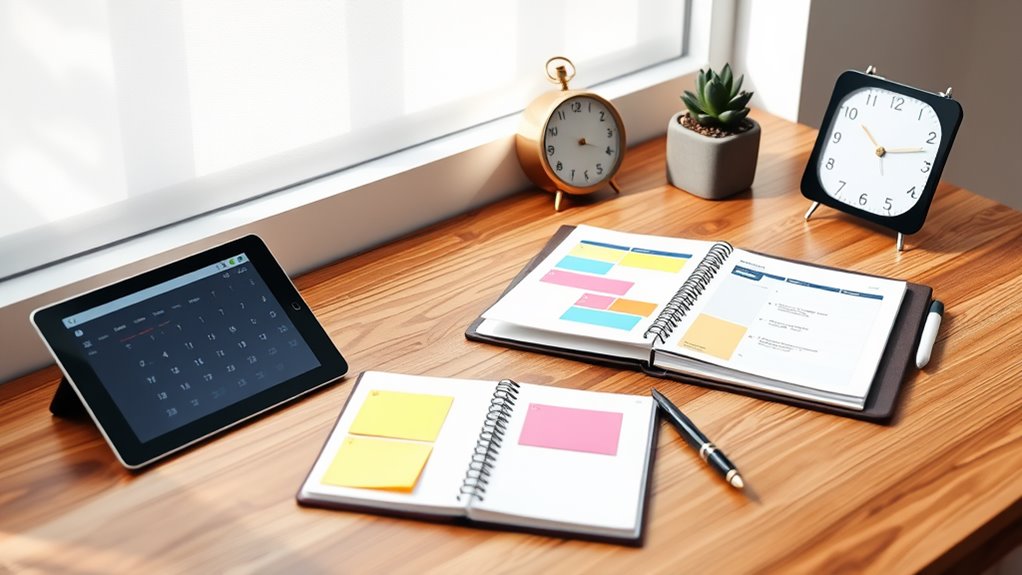Planning Tools You’ll Never Want to Work Without Again
When it comes to planning tools you’ll never want to work without again, project management software and time-tracking apps are your best friends. These tools streamline your workflow, provide real-time collaboration, and help visualize timelines with features like Gantt charts and Kanban boards. Don’t forget effective organizational systems that can help you prioritize tasks and maintain clarity. Also, using must-have collaboration tools like Slack or Google Workspace can enhance communication within your team. By combining these tools and methods, you can optimize your productivity and creativity. Want to discover more about maximizing your planning efficiency? Keep going!
Key Takeaways
- Essential project management software streamlines workflow for task assignment and progress tracking, enhancing overall team productivity.
- Top time-tracking applications like Toggl and Clockify optimize workflow by monitoring productivity and managing project timelines effectively.
- Effective organizational systems utilize digital tools and color-coding to prioritize and categorize tasks for improved clarity and focus.
- Must-have collaboration tools such as Slack and Google Workspace facilitate seamless communication and real-time document collaboration among team members.
- Combining digital and analog planning methods can cater to personal preferences, optimizing productivity and creativity in task management.
Essential Project Management Software
When you’re juggling multiple tasks and deadlines, having the right project management software can make all the difference. It streamlines your workflow, allowing you to assign tasks, set priorities, and track progress all in one place.
You can easily collaborate with your team, share files, and communicate in real-time, reducing the back-and-forth of emails. Look for features like Gantt charts and Kanban boards, which help visualize your project’s timeline and status.
Integrations with other tools you already use can enhance your productivity even further. With the right software, you’ll find it easier to stay organized and meet your goals.
Ultimately, investing in essential project management software saves you time and frustration, letting you focus on what truly matters.
Top Time-Tracking Applications
Managing your projects effectively doesn’t stop at planning and task assignment; tracking how you spend your time is just as important. Time-tracking applications can help you monitor your productivity, identify time sinks, and optimize your workflow. Here are some top choices:
| Application | Key Features | Best For |
|---|---|---|
| Toggl | Simple interface, reporting | Freelancers & teams |
| Clockify | Free version, unlimited users | Budget-conscious teams |
| Harvest | Invoicing, expense tracking | Businesses needing billing |
Effective Organizational Systems
An effective organizational system can transform chaos into clarity, allowing you to streamline your workflow and keep projects on track.
Start by identifying your priorities and categorize tasks accordingly. Use digital tools like to-do lists or project management apps to visualize your workload and deadlines. Color-coding can help you quickly identify urgent tasks at a glance.
Establish a routine for reviewing and updating your tasks regularly, ensuring nothing slips through the cracks. Additionally, create a centralized location for essential documents and notes, making them easily accessible when you need them.
Simplifying your organizational approach not only enhances productivity but also reduces stress, letting you focus on what truly matters. With the right system, you’ll navigate through your workday with confidence and ease.
Must-Have Collaboration Tools
Collaboration tools can elevate your team’s productivity and communication, making it easier to work together, no matter where you are.
Tools like Slack or Microsoft Teams streamline conversations, allowing you to share ideas instantly. Google Workspace lets you collaborate on documents in real-time, ensuring everyone stays on the same page.
For project management, apps like Trello or Asana help you track tasks and deadlines, keeping everyone accountable.
Video conferencing platforms like Zoom or Google Meet let you connect face-to-face, adding a personal touch to remote interactions.
Finally, cloud storage solutions like Dropbox or OneDrive make it simple to share and access files from anywhere.
With these must-have tools, your team can collaborate seamlessly and efficiently, driving better results.
Digital vs. Analog Planning Methods
While digital planning methods offer convenience and flexibility, analog approaches can provide a tactile experience that many find beneficial. You might appreciate the feel of pen on paper as it helps reinforce your thoughts and ideas, making them more memorable.
With analog tools, like planners or bullet journals, you can easily customize layouts and doodle, adding a personal touch to your planning process.
On the other hand, digital tools boast features like reminders, cloud storage, and easy sharing, making collaboration seamless.
Ultimately, the choice between digital and analog methods depends on your preferences and lifestyle. Experiment with both to discover which approach enhances your productivity and aligns with your creative flow.
Finding the right balance could transform your planning experience.
Tips for Seamless Integration
Finding the right balance between digital and analog planning can enhance your productivity considerably.
To achieve seamless integration, consider these tips:
-
Set specific goals: Clearly define what you want to accomplish with both methods.
-
Use compatible tools: Choose apps or planners that sync well together, making shifts easier.
-
Establish a routine: Dedicate time each day to review your plans, switching between digital and analog as needed.
-
Prioritize tasks: Use your favorite method for urgent tasks and the other for long-term planning.
-
Stay flexible: Adapt your system based on what works best for you over time.
Frequently Asked Questions
How Do I Choose the Right Planning Tool for My Team?
To choose the right planning tool for your team, assess your team’s needs, consider budget constraints, explore user-friendly options, and prioritize collaboration features. Test a few tools to see which fits best with your workflow.
Are There Free Versions of These Planning Tools Available?
Yes, there are free versions of many planning tools available. You can explore options like Trello, Asana, or ClickUp, which offer robust functionalities at no cost, helping you manage your team’s projects effectively without breaking the bank.
How Can I Train My Team to Use These Tools Effectively?
To train your team effectively, start with hands-on workshops, encouraging collaboration. Provide clear tutorials and resources, and set up regular check-ins to address challenges. Celebrate small wins to keep everyone motivated and engaged throughout the process.
What Are Common Mistakes When Implementing New Planning Tools?
When implementing new planning tools, you might overlook proper training, fail to communicate changes clearly, or underestimate the time needed for adjustment. These mistakes can hinder your team’s effectiveness and overall project success.
How Do I Measure the Success of a Planning Tool?
To measure the success of a planning tool, track key performance indicators, gather user feedback, and assess improvements in efficiency. Regularly review progress against goals to verify it meets your team’s needs and expectations.





